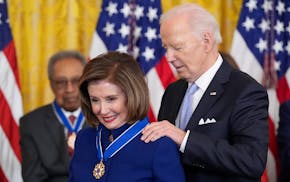Lessons are absorbed so much more easily when you put a little lilt in them.
Maria von Trapp of "The Sound of Music" knew this. So do the teachers at the Wilder Child Development Center in St. Paul. They've teamed up with MacPhail Center for Music on a program that uses rhythm, melody and hands-on practice with instruments to teach alphabet, counting, vocabulary and social skills to pre-kindergartners.
Most preschool classes incorporate a song session into daily activities, but at Wilder, music is a part of lessons all day long, with teachers singing instructions and asking the kids to sing back. Even naptime includes exposure to music; the radio is tuned to MPR's classical station.
How many 4-year-olds know what "staccato" and "legato" mean? The Wilder kids do, thanks to the lively teaching style of MacPhail's Nick Johnson.
"Lay-GAH-toooh," he drawls, rolling a pair of rhythm sticks along the floor. "Stah-CAH-to!" he barks, rapping the sticks sharply. As the children imitate his sounds and movements, they seem to grasp quickly that legato is smooth and slow, staccato fast and sharp.
Many studies have shown that teaching with music not only improves children's ability to master reading and math skills, but also helps them to focus better and retain what they've learned longer. One 2009 study on music's effect on brain activity in young children found that their attention, anticipation and expectation processes were enhanced by music training.
Most important to the children, however, is that what they're doing is fun.
"What family does this belong to?" Johnson asks, hoisting a slide trombone.
"The brass winds family!" chorus the kids, as Johnson calls them up, one by one, to try making sounds with an instrument as big as they are.
"Make a bubble in your mouth and blow!" he says.
A boy named Elliot puffs out his cheeks like a chipmunk and gives it his all, producing a loud, two-toned blat. He smiles proudly at his achievement as his classmates clap.
All of the teachers at the Wilder center are required to sing now and then throughout the day, said center director Judy Ohm. Improvisation is encouraged.
"I tell the kids I'm pulling a word I sing out of the sky, and then they do it, too," she said. "If you sing a directive, they're more ready to learn it, and at the same time we're instilling a love of music in them."
Music is one of the few activities that use all parts of the brain, said Johnson, who is trained in music therapy.
"The ways we move, speak and think are all being affected when we're engaged with music," he said.
Johnson and the Wilder teachers also use music to show the kids how to solve problems, get along and share with one another, and pay attention. About 60 children, mostly low-income and minority, benefit from the classes.
"Everybody sit down on the floor, not on the ceiling, not on the door," Johnson sings, and the kids join in as they gather in a circle. A few squirmers are gently corralled, but most of the children follow orders.
The Learning With Music program began at Wilder seven years ago, when a staff member saw Dianna Babcock, director of MacPhail's early childhood music program, do a presentation and contacted her. The center has tracked a 25 to 40 percent jump in pre-literacy and a 15 to 20 percent improvement in pre-math skills, Babcock said.
"Music actually begins for kids when they're still in the womb, with the mother's heartbeat," she said. "With so many preschool programs, all the music kids get exposed to comes from the teacher putting on a CD. But it's such a wonderful teaching tool when they can participate."
Kristin Tillotson • 612-673-7046

Helen Simonson is in Jane Austen mode with 'The Hazelbourne Ladies Motorcycle and Flying Club'

Biden awards the Medal of Freedom to Nancy Pelosi, Medgar Evers, Michelle Yeoh and 15 others
![Mia's former associate curator of Native American Art Jill Ahlberg Yohe.
] ELIZABETH FLORES • liz.flores@startribune.com](https://arc.stimg.co/startribunemedia/KLM6KWE7YJDQRICKFBZ3QEYRPA.jpg?h=91&w=145&fit=crop&bg=999&crop=faces)
